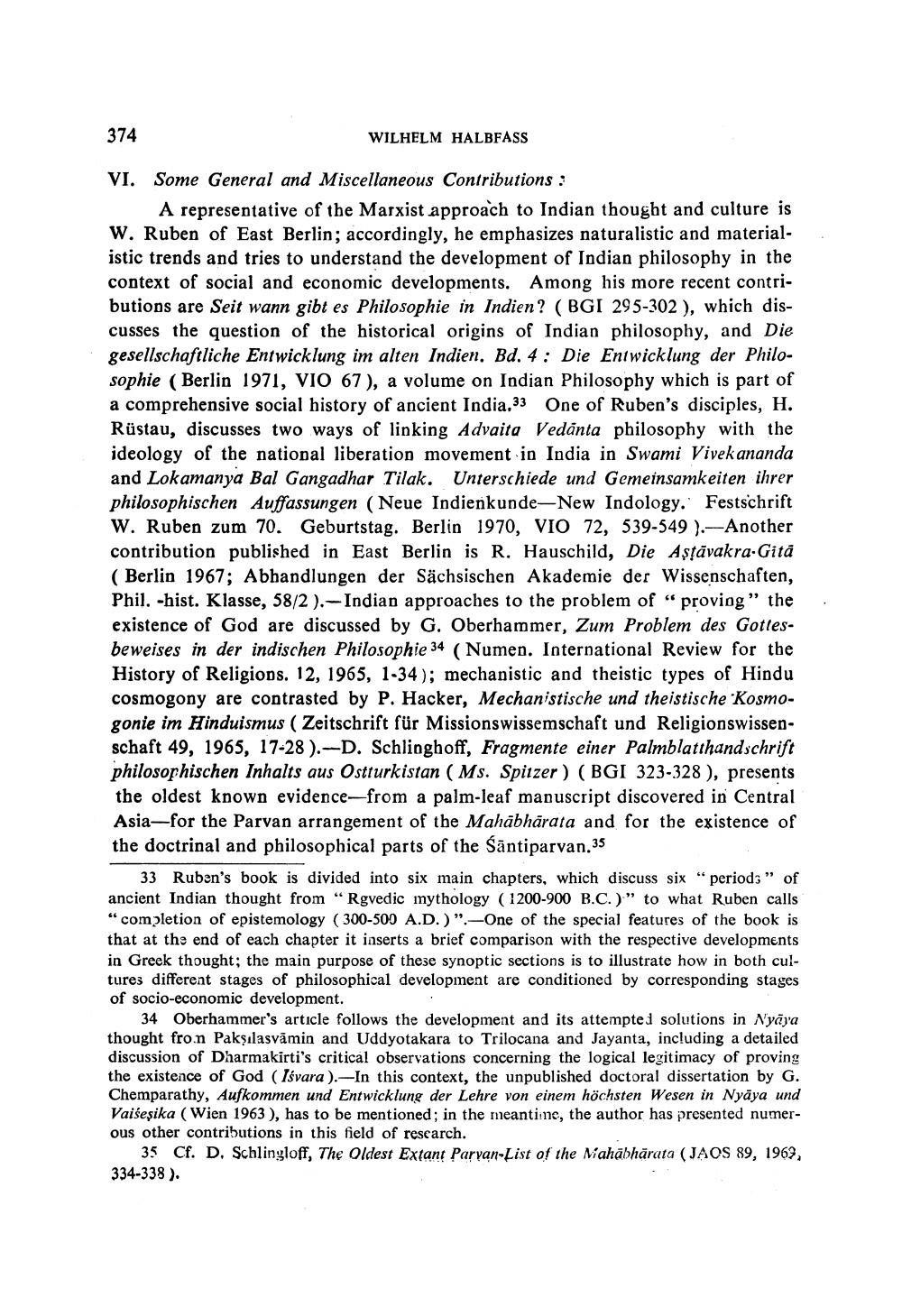________________
374
WILHELM HALBFASS
VI. Some General and Miscellaneous Contributions :
A representative of the Marxist approach to Indian thought and culture is W. Ruben of East Berlin; accordingly, he emphasizes naturalistic and materialistic trends and tries to understand the development of Indian philosophy in the context of social and economic developments. Among his more recent contributions are Seit wann gibt es Philosophie in Indien? (BGI 295-302 ), which discusses the question of the historical origins of Indian philosophy, and Die gesellschaftliche Entwicklung im alten Indien. Bd. 4: Die Entwicklung der Philosophie (Berlin 1971, VIO 67), a volume on Indian Philosophy which is part of a comprehensive social history of ancient India,33 One of Ruben's disciples, H. Rüstau, discusses two ways of linking Advaita Vedanta philosophy with the ideology of the national liberation movement in India in Swami Vivekananda and Lokamanya Bal Gangadhar Tilak. Unterschiede und Gemeinsamkeiten ihrer philosophischen Auffassungen (Neue Indienkunde-New Indology.' Festschrift W. Ruben zum 70. Geburtstag. Berlin 1970, VIO 72, 539-549 ).-Another contribution published in East Berlin is R. Hauschild, Die Aştāvakra.Gita (Berlin 1967; Abhandlungen der Sächsischen Akademie der Wissenschaften, Phil. -hist. Klasse, 58/2).- Indian approaches to the problem of “proving" the existence of God are discussed by G. Oberhammer, Zum Problem des Gottesbeweises in der indischen Philosophie 34 (Numen. International Review for the History of Religions. 12, 1965, 1-34); mechanistic and theistic types of Hindu cosmogony are contrasted by P. Hacker, Mechanistische und theistische Kosmogonie im Hinduismus ( Zeitschrift für Missionswissemschaft und Religionswissenschaft 49, 1965, 17-28).-D. Schlinghoff, Fragmente einer Palmblatthandschrift philosophischen Inhalts aus Ostturkistan (Ms. Spitzer ) (BGI 323-328 ), presents the oldest known evidence-from a palm-leaf manuscript discovered in Central Asia-for the Parvan arrangement of the Mahābhārata and for the existence of the doctrinal and philosophical parts of the sāntiparvan.35
33 Ruben's book is divided into six main chapters, which discuss six "period” of ancient Indian thought from "Rgvedic mythology ( 1200-900 B.C.)." to what Ruben calls "completion of epistemology (300-500 A.D.)".-One of the special features of the book is that at the end of each chapter it inserts a brief comparison with the respective developments in Greek thought; the main purpose of these synoptic sections is to illustrate how in both cultures different stages of philosophical development are conditioned by corresponding stages of socio-economic development.
34 Oberhammer's article follows the development and its attempted solutions in Nyāya thought fro.n Paksılasvämin and Uddyotakara to Trilocana and Jayanta, including a detailed discussion of Dharmakirti's critical observations concerning the logical legitimacy of proving the existence of God (Isvara ).-In this context, the unpublished doctoral dissertation by G. Chemparathy, Aufkommen und Entwicklung der Lehre von einem höchsten Wesen in Nyāya und Vaiseșika Wien 1963), has to be mentioned; in the meantiine, the author has presented numerous other contributions in this field of research.
35 Cf. D. Schlingloff, The Oldest Extant Paryan-List of the Mahābhārata (JAOS 89, 1967. 334-338).




